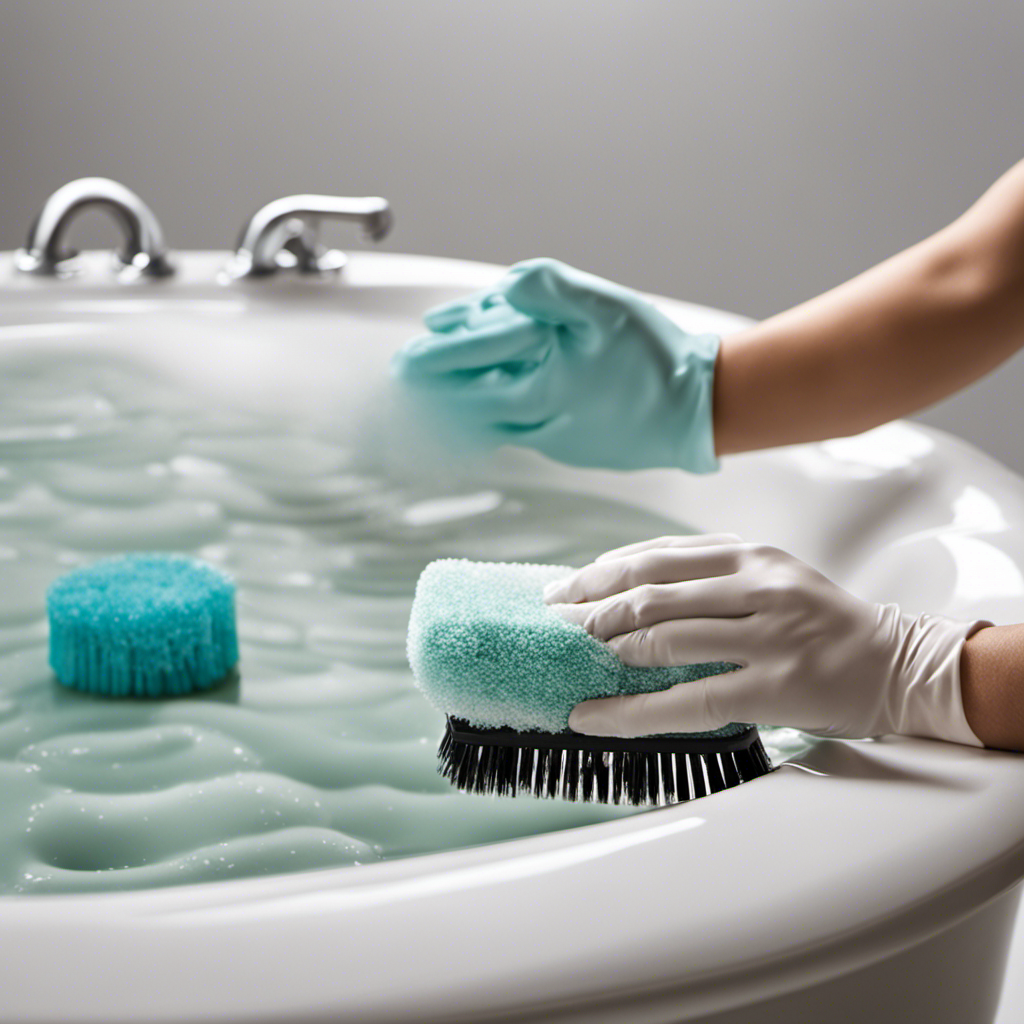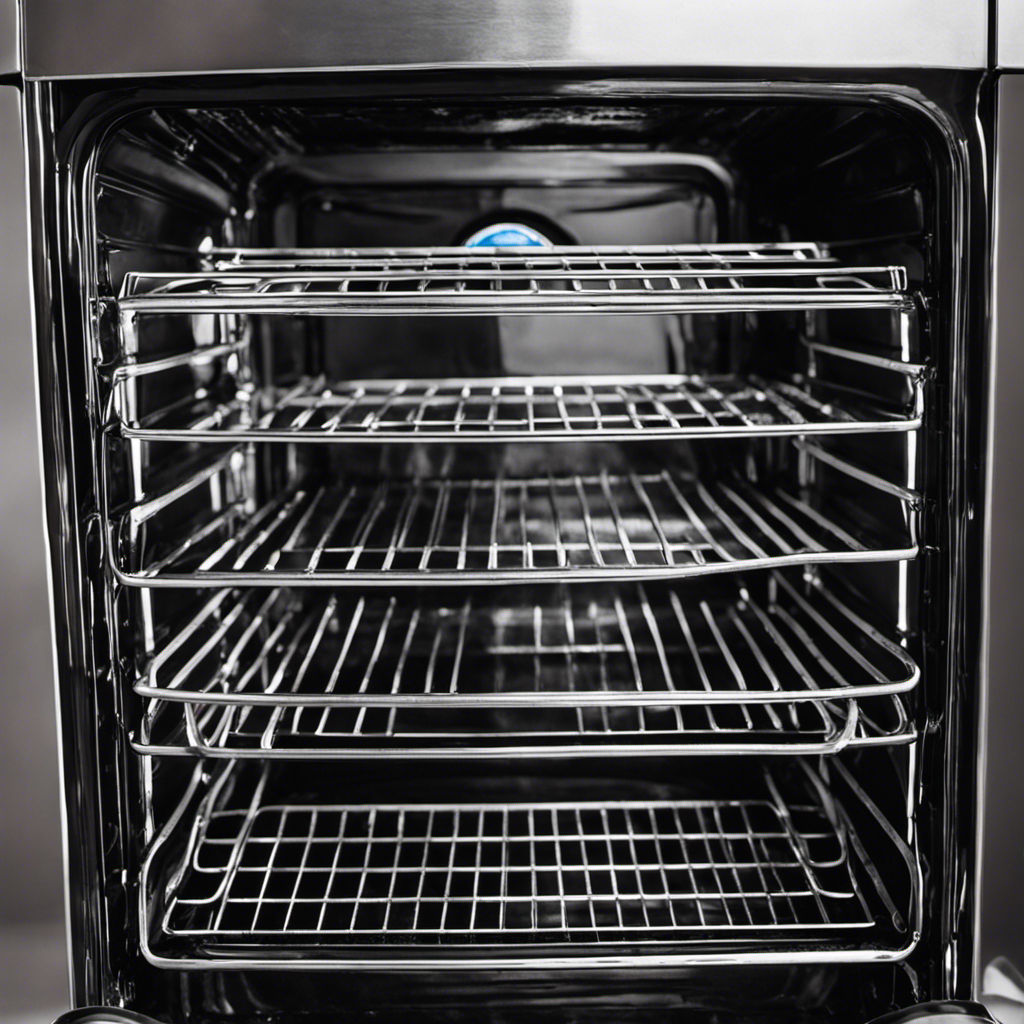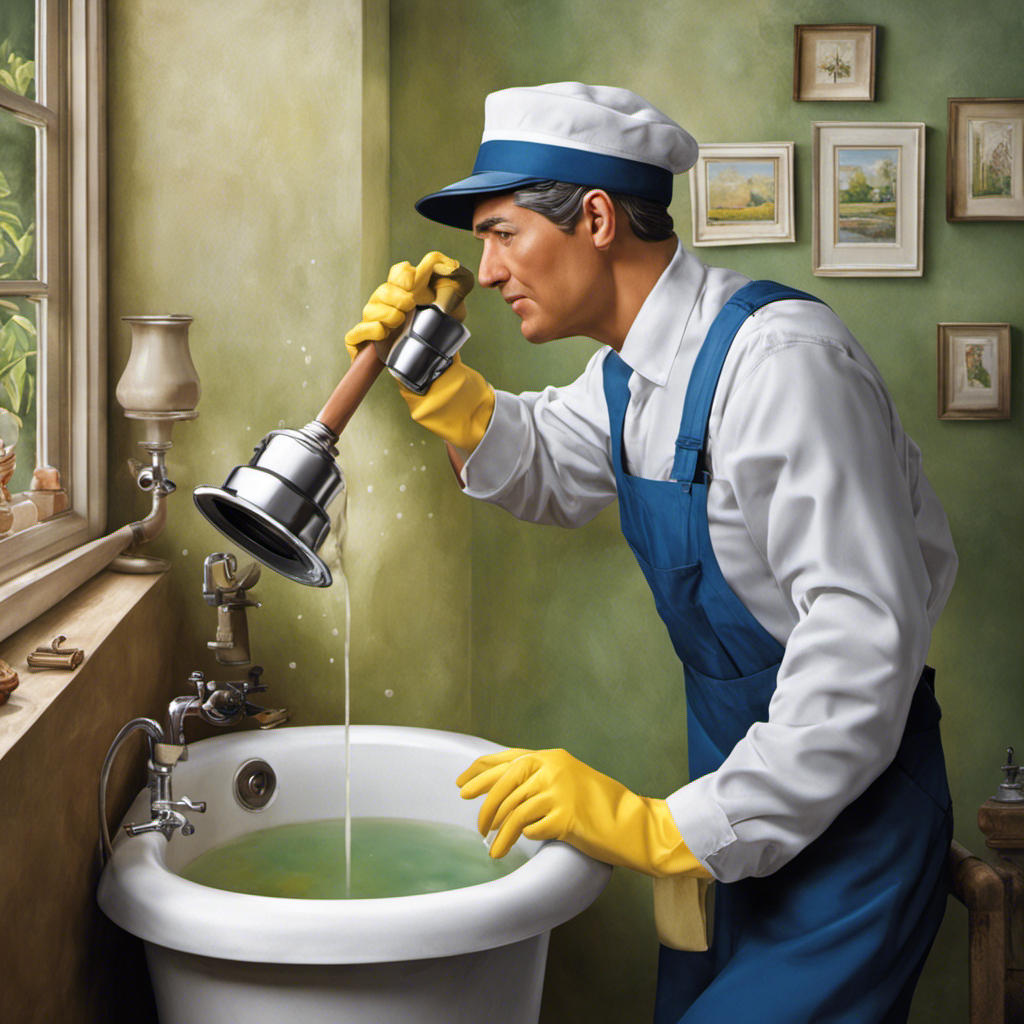So, you’ve stepped into your bathtub and noticed that your bathtub mat is looking a little worse for wear. Don’t worry, cleaning it is easier than you think! In this article, we’ll walk you through the simple steps to get your bathtub mat clean and fresh again.
From gathering the necessary supplies to scrubbing away dirt and grime, we’ve got you covered. Plus, we’ll share some preventive measures to help you maintain a clean mat in the long run.
Let’s get started!
Key Takeaways
- Adhesive mats and non-slip mats are both essential for bathtub safety, with adhesive mats preventing slipping and non-slip mats reducing the risk of accidents.
- Cleaning the bathtub mat involves gathering supplies like a bucket, scrub brush, and mild detergent, removing the mat carefully, using a mixture of baking soda and water for stubborn stains, and thoroughly drying the mat to prevent mildew formation.
- The cleaning solution for the bathtub mat can be prepared by combining white vinegar, baking soda, and lemon juice, and it should be used to gently scrub the mat in circular motions, focusing on heavily soiled areas.
- Proper rinsing and drying methods are important to prevent moisture buildup and mold growth, including rinsing the mat with warm water, shaking off excess water, and hanging the mat in a well-ventilated area to dry completely.
Types of Bathtub Mats
There are two main types of bathtub mats that are commonly used: adhesive and non-slip.
Adhesive mats are typically made of rubber or silicone and have a sticky surface that adheres to the bottom of the bathtub. These mats provide a secure grip and prevent slipping, making them an excellent choice for bathtub safety.
On the other hand, non-slip mats are made of materials like vinyl or rubber and feature suction cups on the underside. These mats create a strong suction to keep them in place, reducing the risk of accidents.
Both types of mats are essential bathroom accessories that help ensure your safety while bathing. It’s important to choose the type that works best for you and your bathtub surface.
Gathering the Necessary Supplies
To gather the necessary supplies for cleaning your bathtub mat, you’ll need a bucket, a scrub brush, and some mild detergent. These items are essential for effectively removing dirt, grime, and mildew from your mat.
When choosing a scrub brush, opt for one with stiff bristles that can easily dislodge dirt particles. A bucket will allow you to mix water and detergent, creating a soapy solution for cleaning.
As for the detergent, it’s recommended to use a mild one to avoid damaging the mat’s material. Avoid using harsh chemicals or bleach, as they can deteriorate the mat’s texture and color.
Removing the Bathtub Mat
To remove the bathtub mat, simply lift it carefully from the surface of the tub. Start by grabbing one corner and slowly peeling it off. Be cautious not to tug too hard, as this could damage the mat or leave residue behind.
Once the mat is removed, you may notice stubborn stains or mildew. To remove stains, use a mixture of baking soda and water. Apply the paste to the stained areas and let it sit for a few minutes before scrubbing with a brush.
To prevent mildew from forming, make sure to thoroughly dry the mat before placing it back in the tub.
Now that you have successfully removed the bathtub mat, let’s move on to preparing the cleaning solution.
Preparing the Cleaning Solution
Once you’ve gathered the necessary ingredients, mix them together to create the cleaning solution.
To ensure an effective cleaning process for your bathtub mat, follow these simple steps:
- Start by pouring a cup of white vinegar into a large bucket.
- Add half a cup of baking soda to the vinegar and stir until it forms a paste.
- Squeeze the juice of one lemon into the mixture and continue stirring.
This powerful cleaning solution combines the natural disinfecting properties of vinegar, the gentle abrasiveness of baking soda, and the fresh scent of lemon. It is a safe and effective way to remove dirt, grime, and mildew from your bathtub mat.
Now that you have prepared the cleaning solution, it’s time to move on to the next step: scrubbing the bathtub mat.
Scrubbing the Bathtub Mat
After you’ve prepared the cleaning solution, it’s time to start scrubbing the bathtub mat to remove any dirt and grime. Using the right scrubbing techniques will ensure a thorough clean.
Begin by wetting the bathtub mat with warm water. Apply a small amount of the cleaning solution onto a sponge or brush, and then gently scrub the mat in circular motions. Pay extra attention to areas that are heavily soiled.
Rinse the mat thoroughly with water to remove any remaining cleaning solution. To maintain a clean and hygienic mat, it is recommended to clean it at least once a week. However, if the mat is used frequently or if there are visible stains, it may require more frequent cleaning.
Rinsing and Drying the Mat
Now that you have scrubbed your bathtub mat, it’s time to focus on rinsing and drying it properly. Follow these rinsing techniques and drying methods to ensure a clean and well-maintained mat:
-
Rinse with warm water: Use a handheld showerhead or a bucket of warm water to thoroughly rinse off any remaining soap or cleaning solution from the mat.
-
Shake off excess water: After rinsing, give the mat a good shake to remove excess water and speed up the drying process.
-
Hang to dry: Hang the mat in a well-ventilated area, preferably outdoors or in a bathroom with good airflow, to allow it to dry completely.
By following these rinsing techniques and drying methods, you can prevent any moisture buildup or mold growth on your bathtub mat.
Now, let’s move on to the next section about preventive measures for maintaining a clean mat.
Preventive Measures for Maintaining a Clean Mat
To keep your mat in good condition, it’s important to take preventive measures and establish a regular cleaning routine. Regular cleaning is crucial because it helps remove dirt, soap scum, and bacteria that can accumulate on the mat over time. By cleaning your mat regularly, you can prevent the growth of mold and mildew, which can be harmful to your health.
Additionally, regular cleaning helps maintain the mat’s grip, ensuring that you don’t slip and fall while in the bathtub. Using a bathtub mat also has several benefits. It provides a non-slip surface, reducing the risk of accidents, especially for children and the elderly. Furthermore, a bathtub mat can protect your bathtub’s surface from scratches and damage caused by abrasive materials.
Alternative Cleaning Methods
You can try using vinegar or baking soda to remove stains and odors from your bathroom mat. These natural cleaning products offer an effective and eco-friendly way to keep your mat fresh and clean.
Here are three DIY cleaning solutions you can try:
-
Vinegar solution: Mix equal parts of white vinegar and water in a spray bottle. Spray the solution onto the stained areas of your mat and let it sit for a few minutes. Scrub the stains with a brush or sponge and rinse with water.
-
Baking soda paste: Make a paste by mixing baking soda with water. Apply the paste to the stained areas and let it sit for 15-20 minutes. Scrub the stains gently and rinse thoroughly.
-
Essential oil spray: Mix a few drops of your favorite essential oil with water in a spray bottle. Spray the solution onto your mat to eliminate odors and leave a refreshing scent.
By using these natural cleaning methods, you can easily remove stains and odors from your bathroom mat without using harsh chemicals.
Now, let’s move on to some safety tips for cleaning bathtub mats.
Safety Tips for Cleaning Bathtub Mats
When it comes to maintaining the non-slip surface of your bathtub mat, there are a few key points to keep in mind.
First, proper cleaning techniques are essential in order to prevent the build-up of dirt, grime, and bacteria.
Second, using the right cleaning products is crucial to ensure that the non-slip surface remains effective and safe.
Lastly, regular maintenance and cleaning will help to prolong the lifespan of your bathtub mat and keep it in top condition.
Non-Slip Surface Maintenance
Maintaining a non-slip surface on your bathtub mat is essential for preventing accidents. A clean and well-maintained mat ensures that you have a secure footing while showering or bathing. Here are a few benefits of having a non-slip surface on your bathtub mat:
- Prevents slips and falls: A non-slip surface provides excellent traction, reducing the risk of slipping and falling in the bathroom.
- Increases safety: By keeping the mat clean and maintaining its non-slip properties, you create a safer environment for everyone, especially children and the elderly.
- Long-lasting durability: Regular maintenance helps extend the lifespan of the mat, saving you money in the long run.
To maintain a non-slip surface on your bathtub mat, you can use homemade cleaning solutions. These solutions are effective and easy to make:
- Vinegar and water: Mix equal parts of white vinegar and water, then spray it on the mat. Scrub gently with a brush or sponge, rinse, and let it air dry.
- Baking soda paste: Make a thick paste by mixing baking soda and water. Apply the paste to the mat, scrub using a brush, rinse, and allow it to dry.
- Lemon juice and salt: Combine lemon juice and salt to create a paste. Apply the paste to the mat, scrub gently, rinse, and let it dry.
Proper Cleaning Techniques
Using homemade cleaning solutions is an effective and convenient way to keep your bathtub mat’s non-slip surface clean and well-maintained. To ensure cleanliness, it is important to establish a regular cleaning frequency. Ideally, you should clean your bathtub mat at least once a week to prevent the buildup of dirt, soap scum, and mildew.
When cleaning, start by removing the mat from the tub and rinsing it with warm water to remove any loose debris. Next, apply a homemade cleaning solution, such as a mixture of vinegar and water or baking soda and water, onto the mat. Scrub gently with a brush or sponge to remove stains and residue.
After cleaning, make sure to thoroughly rinse the mat with water to remove any remaining cleaning solution. To ensure proper drying, hang the mat up or lay it flat in a well-ventilated area. Once the mat is completely dry, you can place it back in your bathtub.
Now that you know the proper cleaning techniques for your bathtub mat, let’s move on to the next section where we will discuss recommended cleaning products.
Recommended Cleaning Products
To keep your bathtub mat’s non-slip surface clean and well-maintained, it’s recommended to use commercial cleaning products specifically designed for bathroom surfaces. These products are effective in removing dirt, grime, and soap scum from your mat, ensuring that it remains hygienic and safe to use.
Here are some recommended cleaning products for your bathtub mat:
- Clorox Disinfecting Bathroom Cleaner: This powerful cleaner kills 99.9% of germs and bacteria, leaving your mat fresh and clean.
- Scrubbing Bubbles Foaming Bathroom Cleaner: This foam-based cleaner easily penetrates and lifts tough stains, making it ideal for deep cleaning your mat.
- Lysol Power Bathroom Cleaner: This cleaner not only removes stains and dirt but also leaves a fresh scent behind, leaving your mat smelling great.
Frequently Asked Questions
How Often Should I Clean My Bathtub Mat?
You should clean your bathtub mat regularly to prevent mildew. Use the best cleaning products to effectively remove dirt and grime. Regular cleaning will maintain hygiene and prolong the lifespan of your mat.
Can I Use Bleach to Clean My Bathtub Mat?
Yes, you can use bleach to clean your bathtub mat, but there are also bleach alternatives available. When cleaning, consider using the best cleaning products for bathtub mats to ensure effective and safe results.
What Should I Do if My Bathtub Mat Has Mildew Stains?
To remove mildew stains from your bathtub mat, mix equal parts of vinegar and water in a spray bottle. Spray the solution onto the stains and let it sit for 15 minutes before scrubbing with a brush. To prevent future mildew growth, make sure to regularly clean and dry your bathtub mat.
Can I Put My Bathtub Mat in the Washing Machine?
Yes, you can put your bathtub mat in the washing machine. However, if you’re looking for alternative cleaning methods, there are other effective options available. Let’s explore the best ways to clean your bathtub mat.
How Long Does It Take for a Bathtub Mat to Dry After Cleaning?
To quickly dry your bathtub mat after cleaning, try using a fan or hanging it up to air dry. You can also use a towel to absorb excess moisture. Using a fast-drying cleaning product can also help speed up the drying process.
Conclusion
In conclusion, cleaning your bathtub mat is a necessary chore that can be easily accomplished with the right supplies and techniques. By following the steps outlined in this article, you can ensure that your mat remains clean, hygienic, and safe to use.
Remember, a clean bathtub mat not only provides a comfortable bathing experience but also promotes a sense of relaxation and tranquility. So, take the time to clean your mat regularly and enjoy a pristine bathtub that invites you to unwind and rejuvenate.










